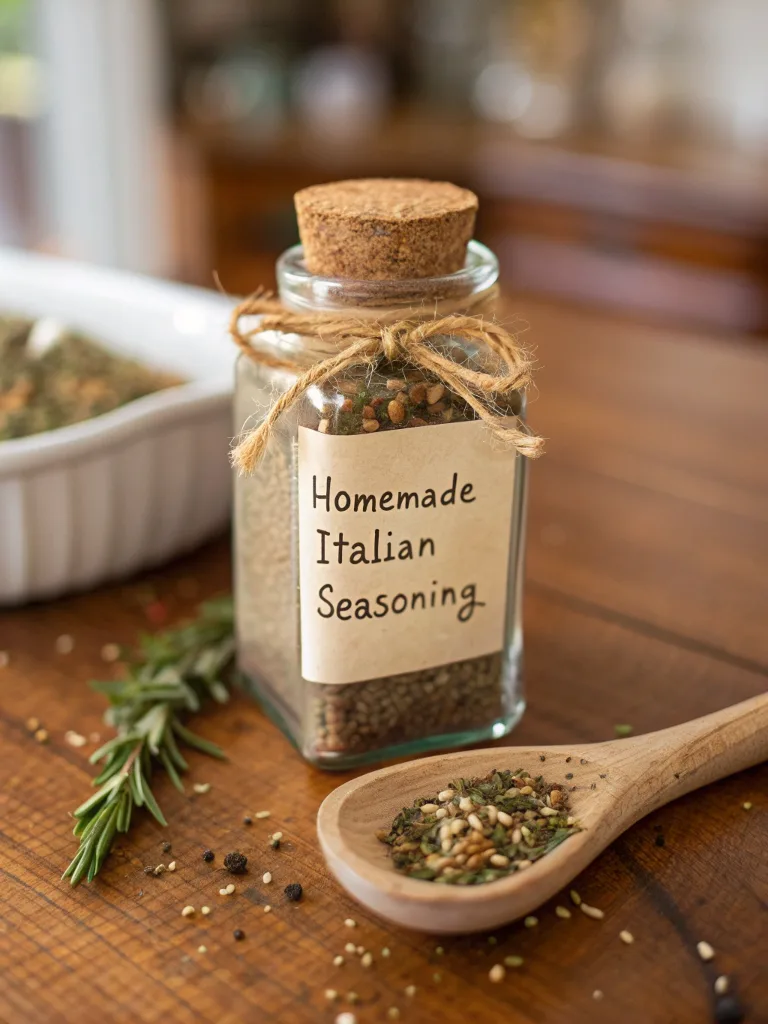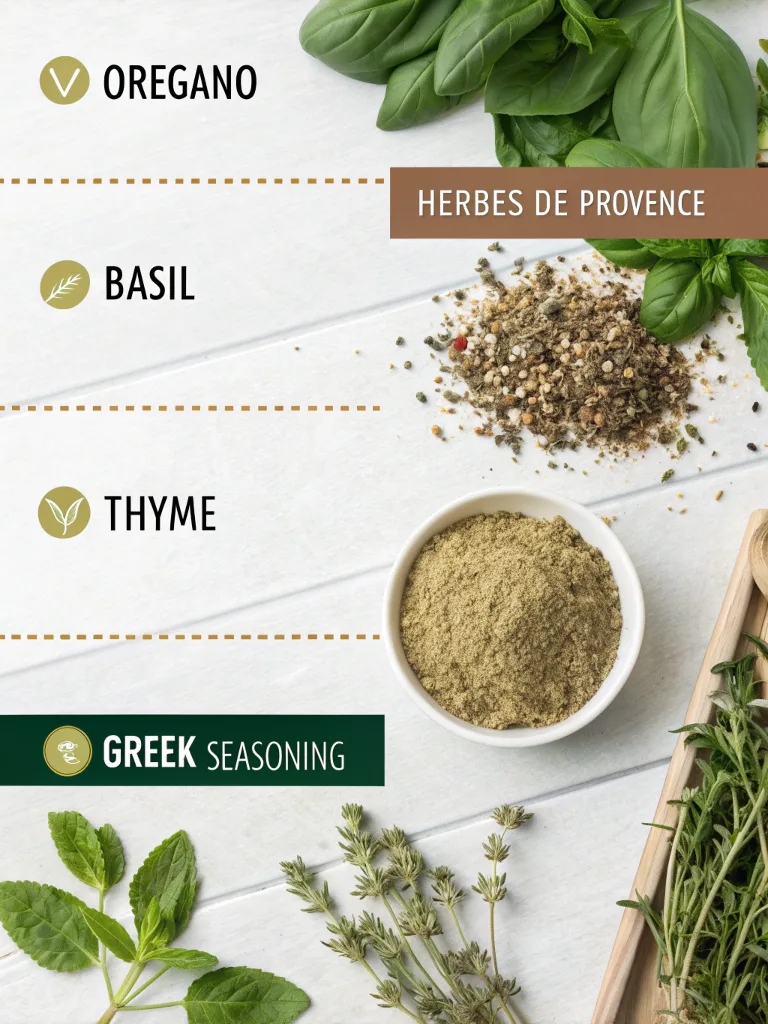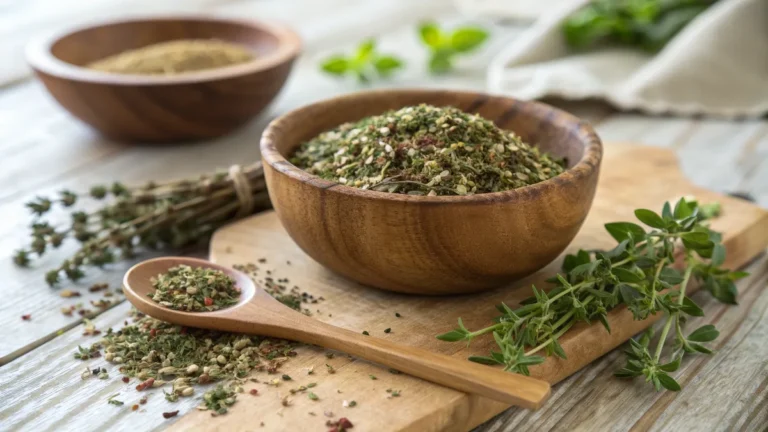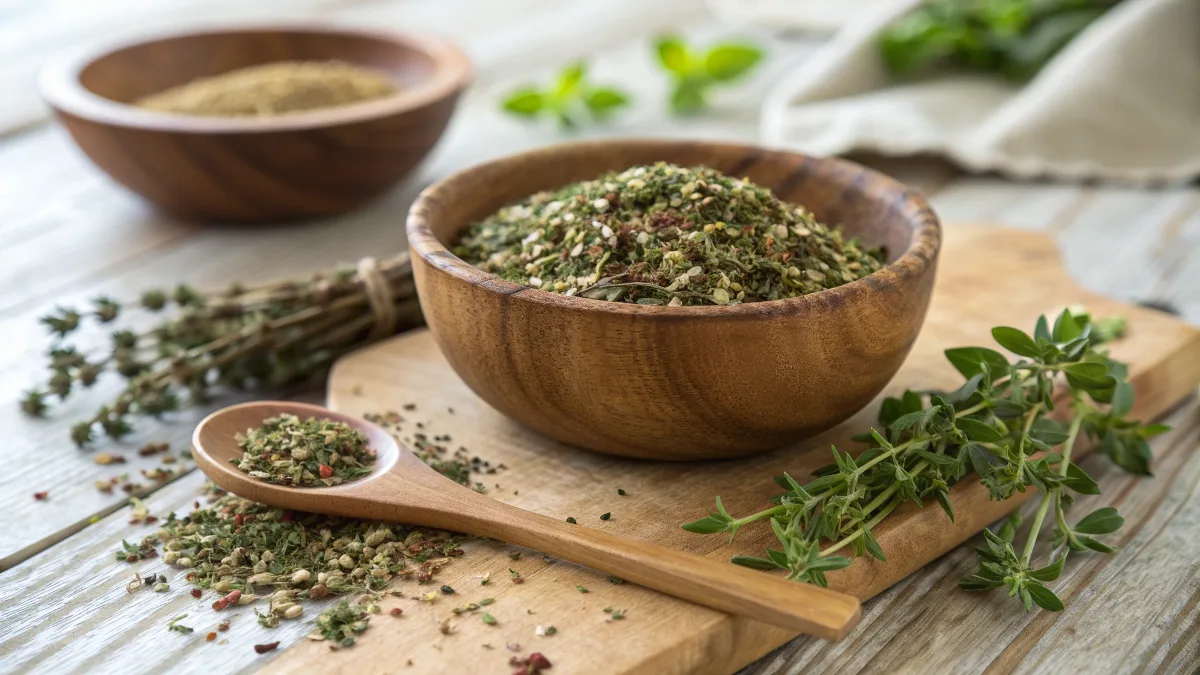Substitute for Italian seasoning is a common kitchen dilemma for home cooks who run out of this essential herb blend while preparing their favorite recipes. Whether you’re making a hearty pasta sauce, a flavorful marinade, or a delicious roasted vegetable dish, Italian seasoning adds a perfect balance of earthiness, sweetness, and depth. But what if you don’t have any on hand?
Fortunately, there are plenty of ways to replace this staple using individual herbs or alternative spice blends. In this guide, we’ll explore the best substitutes for Italian seasoning, from simple two-ingredient swaps to homemade mixes that capture its signature Mediterranean flavors.
Understanding Italian Seasoning
Italian seasoning is a versatile herb blend used in a variety of dishes, bringing the signature flavors of Mediterranean cuisine to home-cooked meals. It is a staple in many kitchens, known for its ability to enhance pasta sauces, meats, and roasted vegetables with its aromatic and earthy notes. While the exact composition of Italian seasoning may vary, its core ingredients remain consistent across most blends.
Composition: Common Herbs in Italian Seasoning

Italian seasoning is primarily made up of dried herbs, carefully chosen to mimic the traditional flavors of Italian cooking. While fresh herbs can be used in certain recipes, dried herbs offer a longer shelf life and a more concentrated taste. Below is a breakdown of the most common herbs found in Italian seasoning:
A well-balanced substitute for Italian seasoning should include a mix of dried herbs like oregano, basil, and thyme.
| Herb | Flavor Profile | Common Uses |
|---|---|---|
| Oregano | Earthy, slightly bitter, and robust | Tomato sauces, grilled meats, and soups |
| Basil | Sweet, peppery, and slightly minty | Pesto, pasta dishes, and caprese salad |
| Thyme | Subtle mint and lemon notes | Roasted meats, seafood, and stews |
| Rosemary | Piney and aromatic | Bread, roasted potatoes, and marinades |
| Marjoram | Mild, floral, and slightly sweet | Salads, stuffing, and grilled vegetables |
| Sage | Warm, savory, and slightly peppery | Poultry dishes, soups, and sauces |
These herbs work together to create a well-balanced blend, enhancing both simple and complex dishes.
Flavor Profile of Italian Seasoning
The taste of Italian seasoning is a harmonious mix of earthy, sweet, and slightly peppery notes. The robust flavor of oregano pairs well with the sweetness of basil, while rosemary and thyme provide a woodsy undertone. Marjoram adds a delicate floral essence, and sage contributes a warm, slightly peppery depth.
A well-made Italian seasoning should have a balanced taste, ensuring that no single herb dominates the blend. The key is in the proper ratio, allowing each herb to complement the others rather than overpower them. This complexity makes Italian seasoning ideal for a wide range of dishes, from rich pasta sauces to light vegetable stir-fries.
Culinary Uses of Italian Seasoning
Italian seasoning is widely used in a variety of recipes, both in traditional Italian cuisine and other Mediterranean-inspired dishes. Here are some of its most common culinary applications:
| Dish Type | How Italian Seasoning Enhances the Flavor |
|---|---|
| Pasta Sauces | Adds depth to tomato-based and creamy sauces |
| Pizza | Infuses the crust and toppings with a bold aroma |
| Soups and Stews | Elevates broths with earthy and herbal notes |
| Roasted Meats | Acts as a seasoning rub for chicken, pork, and beef |
| Vegetable Dishes | Enhances grilled and roasted vegetables |
| Salad Dressings | Provides a fresh and zesty element to vinaigrettes |
With its versatile nature, Italian seasoning serves as a one-stop solution for adding rich flavors to home-cooked meals.
For a hearty meal that benefits from Italian seasoning, try our Old Fashioned Stuffed Bell Peppers Recipe.
For a rich and versatile sauce, consider our Tomato Gravy Recipe, which pairs wonderfully with Italian seasoning.
Why Consider Substitutes?
While Italian seasoning is a kitchen essential, there are times when a substitute is necessary. Whether due to availability, dietary needs, or personal taste preferences, there are many reasons why someone might seek an alternative.
Availability Issues
There are moments when Italian seasoning is simply not available in the pantry. In such cases, understanding which herbs to use as substitutes can save time and effort. Some of the most common availability issues include:
- Running out unexpectedly while cooking.
- Limited grocery store options in certain regions.
- Travel or relocation where specific spice blends may not be accessible.
Dietary Preferences
Some individuals may need a modified version of Italian seasoning due to dietary restrictions, such as:
- Low-sodium diets – Some commercial blends contain added salt.
- Allergies to specific herbs – Some people may be sensitive to certain spices.
- Organic-only preferences – A homemade blend ensures control over ingredient sources.
When choosing a substitute for Italian seasoning, consider the flavor profile of your dish.
Flavor Customization
Homemade Italian seasoning allows for greater flexibility in adjusting flavors. Some cooks prefer a stronger basil presence, while others might reduce rosemary for a milder taste. Adjusting the herb ratio enables a more personalized and customized experience.
Homemade Italian Seasoning Recipe

Making Italian seasoning at home is simple and allows for freshness, customization, and cost savings.
If you need a quick substitute for Italian seasoning, combining oregano and basil is a simple solution.
A homemade substitute for Italian seasoning allows you to customize the flavor to your preference.
Ingredients
A homemade blend should contain equal parts of key herbs, adjusted based on preference:
| Ingredient | Amount | Flavor Contribution |
|---|---|---|
| Dried Oregano | 2 tbsp | Earthy, slightly bitter |
| Dried Basil | 2 tbsp | Sweet and slightly peppery |
| Dried Thyme | 1 tbsp | Minty with lemony undertones |
| Dried Rosemary | 1 tbsp | Piney and bold |
| Dried Marjoram | 1 tbsp | Mild and slightly floral |
| Dried Sage | 1 tsp | Warm and savory |
Preparation Steps
- Measure out all the ingredients and place them in a bowl.
- Crush larger herbs like rosemary between your fingers or with a mortar and pestle to release their aroma.
- Mix everything together evenly to ensure a well-balanced blend.
- Transfer the mix into an airtight container or spice jar.
- Label and store in a cool, dry place.
Storage Tips
- Use an airtight container to prevent moisture absorption.
- Keep the seasoning in a dark, cool location to maintain potency.
- Replace every 6-12 months as dried herbs lose their strength over time.
Alternative Substitutes for Italian Seasoning

When Italian seasoning is unavailable, other single herbs or spice blends can be used as a substitute.
The best substitute for Italian seasoning depends on the dish you are preparing.
Individual Herbs as Substitutes
If you don’t have a blend, using individual herbs can still create a similar effect:
| Herb Combination | Best Use Case |
|---|---|
| Oregano + Basil | Pasta sauces, pizza toppings |
| Thyme + Rosemary | Roasted meats, stews |
| Marjoram + Oregano | Lighter dishes like salads |
Herbes de Provence vs. Italian Seasoning
Herbes de Provence is often suggested as a substitute, but there are some differences:
| Feature | Italian Seasoning | Herbes de Provence |
|---|---|---|
| Contains Oregano | Yes | Yes |
| Contains Basil | Yes | No |
| Includes Lavender | No | Sometimes |
| Flavor Profile | Earthy and robust | Floral and slightly sweet |
Greek Seasoning as an Alternative
Greek seasoning includes similar herbs but often has garlic and onion powder. While not identical, it works well for meat marinades and roasted vegetables.
Fresh Herbs as a Substitute
Fresh herbs offer a brighter, more intense flavor but should be used in larger amounts than dried herbs. Triple the amount of fresh herbs compared to dried ones for the same effect.
Application Tips: Using Substitute for italian seasoning in Recipes
Using a substitute for Italian seasoning requires a careful balance to ensure the intended flavor profile remains intact. While some alternatives work as a 1:1 replacement, others require adjustments in quantity or pairing with additional ingredients. Below are essential tips for effectively incorporating substitute for Italian seasoning into various dishes.
Understanding how to use a substitute for Italian seasoning ensures that your recipes retain their authentic taste.
Measurement Adjustments
Since some substitutes may have a stronger or milder flavor, it’s important to adjust the quantity accordingly. The table below provides a guideline for replacing Italian seasoning in different recipes:
| Substitute | Replacement Ratio | Best Used In |
|---|---|---|
| Oregano + Basil (1:1) | 1 tsp Italian seasoning = ½ tsp oregano + ½ tsp basil | Pasta sauces, pizza, soups |
| Herbes de Provence | 1 tsp Italian seasoning = ¾ tsp Herbes de Provence | Roasted meats, stews, marinades |
| Greek Seasoning | 1 tsp Italian seasoning = 1 tsp Greek seasoning | Grilled meats, Mediterranean dishes |
| Fresh Herbs | 1 tsp dried Italian seasoning = 1 tbsp fresh herbs | Salads, bruschetta, fresh pasta |
For stronger substitutes like Herbes de Provence, reducing the quantity slightly can prevent the dish from becoming overly floral.
Flavor Pairing
Different substitute for Italian seasoning work best with specific types of dishes. Choosing the right one ensures that the overall flavor remains balanced and authentic.
Using the right substitute for Italian seasoning can enhance your dish without altering its intended flavor.
| Dish Type | Best Substitute | Why It Works |
|---|---|---|
| Tomato-Based Sauces | Oregano + Basil | Preserves the classic Italian flavor |
| Roasted Vegetables | Herbes de Provence | Adds depth with thyme and rosemary |
| Grilled Chicken | Greek Seasoning | Enhances savory and slightly tangy notes |
| Soups & Stews | Fresh Herbs | Adds brightness and freshness |
By selecting the appropriate substitute for Italian seasoning, home cooks can achieve a well-balanced, flavorful dish without compromising on taste.
Enhance your pasta dishes with our Chicken Alfredo Recipe with Jar Sauce, where Italian seasoning can elevate the flavor.
Our Tuna Helper Recipe becomes even more delightful with a sprinkle of Italian seasoning.
Cooking Techniques: When to Add Substitutes
Just like Italian seasoning, its substitutes should be added at the right time during cooking for the best results.
- Dried Herbs: Add early in the cooking process to allow flavors to develop.
- Fresh Herbs: Add at the end for a burst of freshness.
- Blends with Garlic/Onion Powder: Reduce any additional garlic/onion in the recipe to avoid overpowering flavors.
With these strategies, substitute for Italian seasoning can seamlessly replace the original blend in most recipes.
FAQs: requently Asked Questions About substitute for Italian seasoning
What is closest to Italian seasoning?
The closest match is a combination of oregano and basil in equal parts. These two herbs form the base of Italian seasoning and work well in most dishes. If available, adding thyme or marjoram can further refine the flavor.
What is Italian seasoning made of?
Italian seasoning typically includes dried oregano, basil, thyme, rosemary, marjoram, and sometimes sage. Some variations may also include garlic powder or crushed red pepper flakes for additional depth and heat.
Can I substitute Italian seasoning with Herbes de Provence?
Yes, but with caution. Herbes de Provence contains lavender, which adds a slightly floral note that may not be suitable for all dishes. It works best in roasted meats, vegetables, and stews, but for tomato-based dishes, it may alter the traditional Italian flavor.
Is oregano the same as Italian seasoning?
No, but oregano is a key component of Italian seasoning. While oregano alone can work as a substitute in a pinch, it lacks the complexity of basil, thyme, and rosemary found in a full Italian seasoning blend.
Can you use parsley instead of Italian seasoning?
Parsley is not a suitable substitute on its own as it lacks the depth and aroma of the other herbs. However, when combined with oregano and basil, it can contribute a mild herbal touch to pasta sauces and dressings.
Is Italian seasoning the same as thyme?
No, thyme is just one component of Italian seasoning. While thyme can mimic some of the herbaceous notes, it does not provide the full-bodied flavor needed to replace Italian seasoning entirely. Combining thyme with oregano and basil creates a more balanced alternative.

Substitute for Italian Seasoning: How to Make Your Own Blend
Running out of Italian seasoning? No worries! Here are the best substitutes, from simple herb combinations to homemade blends that capture the classic Mediterranean flavors.
- Total Time: 5 minutes
- Yield: 1 small jar 1x
Ingredients
- 2 tbsp dried oregano
- 2 tbsp dried basil
- 1 tbsp dried thyme
- 1 tbsp dried rosemary
- 1 tbsp dried marjoram
- 1 tsp dried sage
Instructions
- Measure out all the dried herbs.
- Crush rosemary slightly to release its aroma.
- Mix all the ingredients thoroughly.
- Store in an airtight container in a cool, dry place.
- Use as a 1:1 substitute for Italian seasoning in recipes.
Notes
This homemade blend allows customization based on personal taste preferences. Store in an airtight container for up to 6 months for the best flavor.
- Prep Time: 5 minutes
- Cook Time: 0 minutes
- Category: Spices & Blends
- Method: Mixing
- Cuisine: Mediterranean
Nutrition
- Serving Size: 1 tsp
- Calories: 2
- Sugar: 0g
- Sodium: 0mg
- Fat: 0g
- Saturated Fat: 0g
- Unsaturated Fat: 0g
- Trans Fat: 0g
- Carbohydrates: 0.5g
- Fiber: 0.2g
- Protein: 0.1g
- Cholesterol: 0mg
Keywords: Italian seasoning, herb blend, spice substitute
All nutritional values and baking times are approximate and may vary based on ingredients, equipment, and altitude. Please adjust as needed.
Conclusion
Finding the right substitute for Italian seasoning ensures that home-cooked meals remain flavorful even when the original blend is unavailable. Whether using individual herbs, alternative spice blends, or fresh ingredients, each substitute offers unique qualities that can be tailored to different recipes.
Homemade Italian seasoning blends allow for greater flexibility and customization, ensuring that each dish is seasoned according to personal taste. By understanding how to properly substitute Italian seasoning, home cooks can continue creating delicious and authentic Mediterranean-inspired dishes without interruption.
Making your own substitute for Italian seasoning is a cost-effective and convenient solution for home cooks.
Table of Contents
Thank you for reading our guide on finding the perfect substitute for Italian seasoning! We hope these tips help you keep your dishes flavorful, even when you’re out of your favorite herb blend. If you love experimenting with seasonings and recipes, make sure to follow us on social media for more culinary inspiration:
📌 Pinterest: Explore our recipe boards for more seasoning ideas!
📘 Facebook: Join our food-loving community for tips and new recipes!
🐦 Twitter (X): Stay updated with the latest seasoning hacks and recipes!
Looking for even more ideas on how to replace Italian seasoning? Check out this helpful guide on alternative blends: Italian Seasoning Substitute.
Happy cooking, and don’t forget to share your favorite seasoning substitutes with us on social media! 🍽️✨

